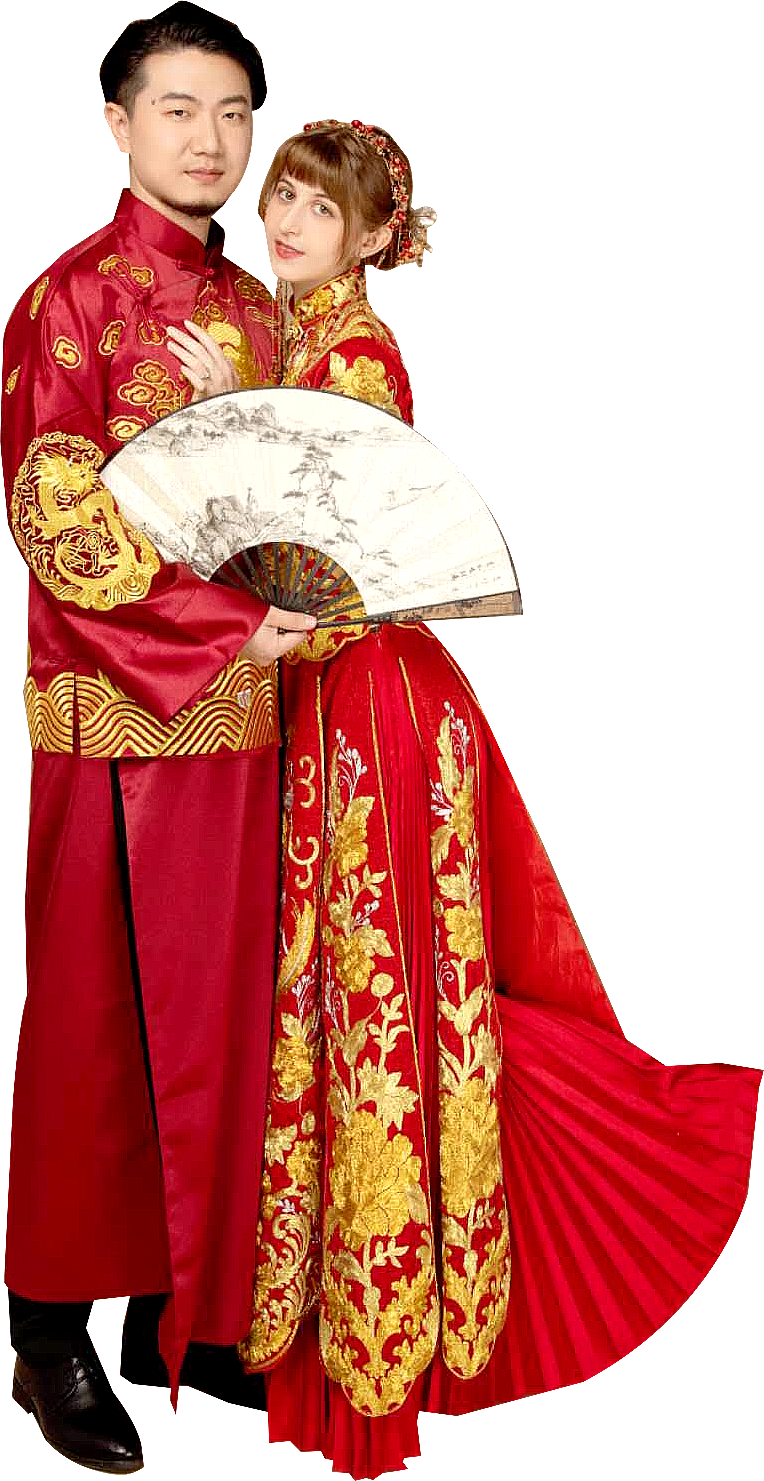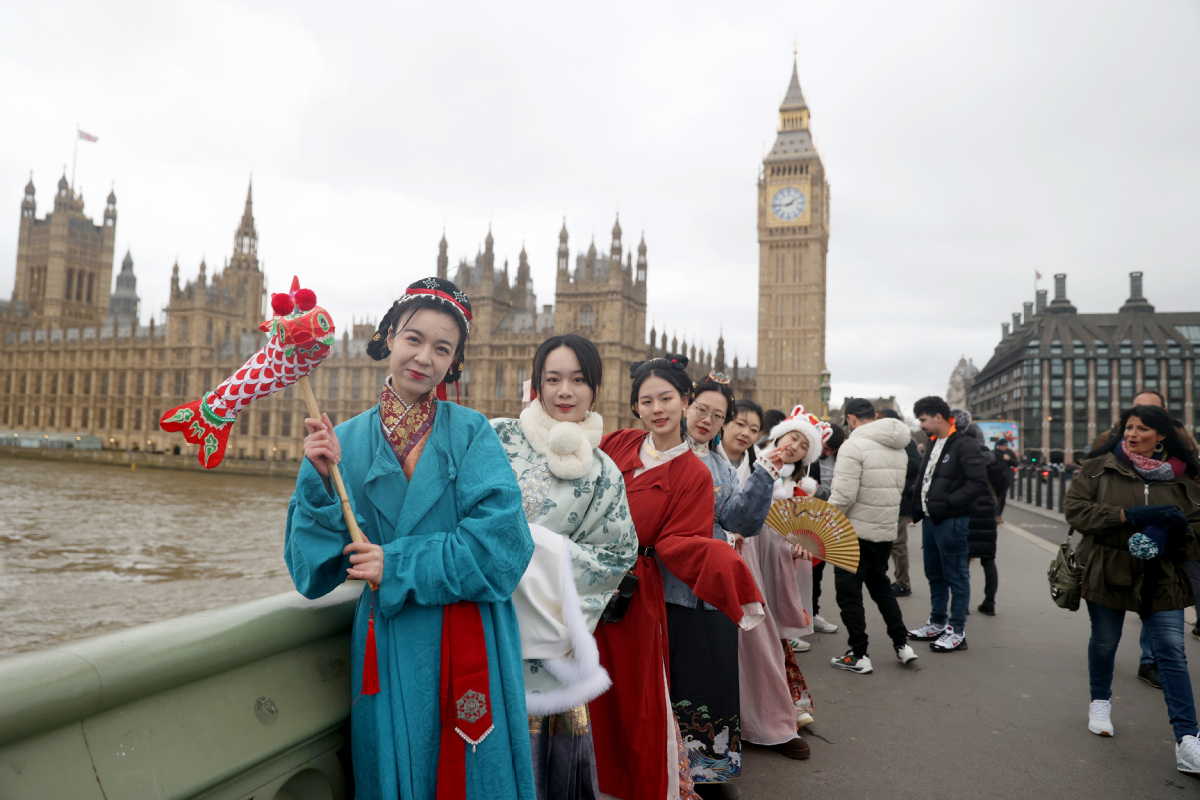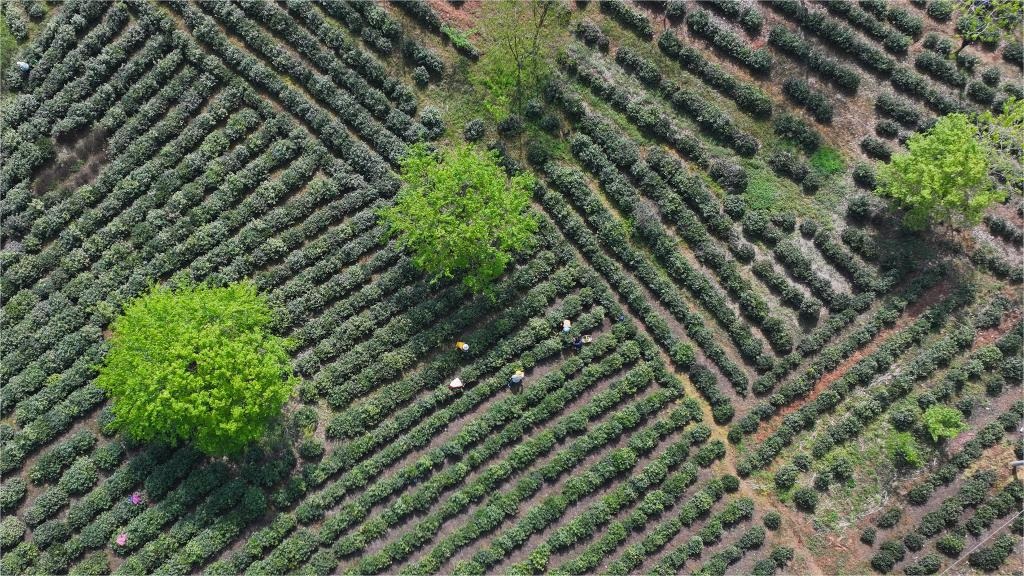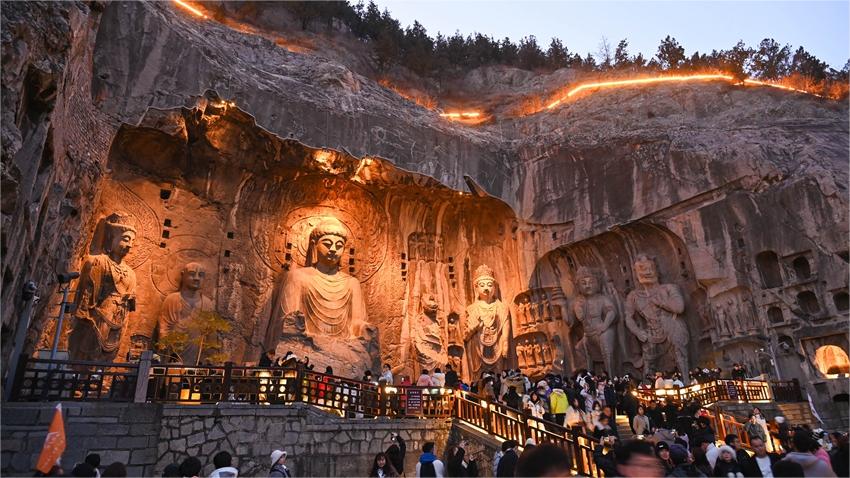Overseas hanfu clubs serve as cultural ambassadors

A student from the Confucius Institute of Belgrade poses in hanfu in the Serbian capital in September last year. XINHUA
Serving as more than just fabric, the traditional Chinese hanfu continues to weave a cultural tapestry that binds individuals, communities and nations.
Hanfu, the traditional attire of the Han ethnic group in China, boasts a history spanning nearly 4,000 years. In recent times, there has been a resurgence of interest in hanfu in China and the United States, as more people are drawn to wearing and analyzing it.
Rachel Yu, from Boston, told China Daily that her introduction to hanfu came unexpectedly one day while she was browsing art documentaries online. It was a chance encounter with a hanfu video that captivated her attention.
"I was like, well, this is very cool, but I didn't think that much about it," she said, noting that the clothing truly stands out from many fashions she had seen in the past.
Yu developed her interest in hanfu after marrying her Chinese husband, who gifted his wife her first set of hanfu and introduced her to more knowledge about traditional clothing.
"Then, I was looking online at all the pictures, trying to learn, is this from the Ming Dynasty (1368-1644)? Is this from the Tang Dynasty (618-907)? How do you style it? What hairstyle matches? How did they do their makeup? It's just like going down the internet rabbit hole and never coming back out," Yu said.
She always asks questions, expressing fascination whenever encountering hanfu online or seeing people wearing different kinds of the attire.
"And there's a lot of variety in the different dynasties because it is so many years," she said. Yu said the one she likes the most is from the Ming Dynasty.
"It goes so well with everything. You can just wear that in your daily life with a sweater or something. And it's so pretty and fancy that it suits daily life well," she said.
Yu added that she also likes to wear the Ru skirt — which is made up of a short jacket and a long skirt — that was very popular during the Tang Dynasty.
"Wearing it now would be too cold, but the makeup is so fun because they have all the flowers and stuff drawn on their faces," she said.
Yu said that she has accumulated some knowledge about hanfu, but the beginning of the research process was very hard for her as a foreigner.
"When I watch Chinese videos about hanfu, to be honest, I'm just looking at the visuals. But the details of what they're saying, unless they're showing it on screen, I don't understand," she said. "It was very hard to research because there is almost nothing about hanfu in English to teach people about (the attire)."
She said she decided to search online and usually found answers through blog posts, so she could ask specific questions and seek help. Yu is now learning Chinese to know more about the traditional clothing from a faraway country.
To encourage herself to learn Chinese, Yu opened accounts on Douyin and TikTok platforms to record the process. To her surprise, she gained as many as 53,000 followers who were interested in the Western girl, who was deeply immersed in Chinese culture. Additionally, people were learning English content about hanfu.
Yu is not only a student but also an ambassador who is a bridge between Chinese hanfu culture and international fans around the world.
"It sort of snowballed into the account becoming more hanfu over time," she said. "When I was trying to figure out how to do my hair because a lot of hanfu videos just show premade hairpieces, suddenly, a flash of inspiration rushed into my head: why don't I make my own hairpieces," she said.
"So I tried to look at what the hair looked like. I examined old drawings, and statues from online or museums. And I thought, how can I replicate this? So I tried to copy it. And then people, mostly in China, were like, 'What? What is the white girl doing?'." Yu said that was how she started posting hanfu-related content on her account.
"Sharing more about making the hair, because I found it really fun, and other people found it interesting as well. But I didn't have any intention of being a hanfu teacher. I'm not qualified for that at all," she said, citing the long history and variety of types and styles of hanfu.
"And as someone in America who wears hanfu, I think that shines a great positive light on Chinese culture, because a lot of people in America don't know much about China," she said. Yu added that her interest in hanfu brought her friendships with other lovers of the traditional Chinese attire, as she joined the hanfu club in Boston.
Yu wore hanfu for her wedding, and also wears it with her husband and friends during Chinese festivals and other important events. She also likes to incorporate hanfu-related elements into her daily life.
"I just find it very interesting and also often functional as well," Yu said. "For example, the horseface dress is very convenient for daily usage. I could just wear the skirt or just wear the vest and, add it to your everyday outfit."
Yu said she felt really welcomed by the hanfu community and believed that the "magic clothing "has helped her build many personal connections and friendships.
"Hanfu is really a way to smooth the relationship between two countries also," she said. "You have the cultural connection; then people start ignoring the government because they care about their own opinion more. They want to know the country more through the culture and friendship, and form their own personal understanding."

Rachel Yu, from Boston, developed an interest in hanfu after marrying her Chinese husband, who introduced her to more knowledge about hanfu. CHINA DAILY
Global network
While bridging the people-to-people interest in hanfu, it also expands a network across the globe and has an increasing presence through communities that represent Chinese heritage and culture.
Ming Liang, president of the New York Hanfu Corporation, said that they have a large hanfu club network across the US, with more than a dozen clubs in different states that operate independently but maintain regular connections.
"During the pandemic, we had an online hanfu gathering. At that time, people from five continents and eight countries attended, with hundreds of participants simultaneously online," she recalled with pleasant surprise.
"Our members here are either second-generation Chinese immigrants or people from China who are studying abroad," Ming said.
She said her hanfu club is a government-registered nonprofit organization that has around 300 active members, with weekly activities and celebrations on important dates.
Studying folklores and having previously taught Chinese herself, Ming has been interested in Chinese culture and has devoted herself to operating the club. The board of the hanfu nonprofit is made up of people from different backgrounds, from finance to IT, but they are brought together by the same interest.
Ming said the first time she participated in activities for Tomb Sweeping Day, was a memorable experience. This traditional festival is devoted to remembering and honoring the deceased, but it also signifies the arrival of spring, during which people typically go on outings. She was attracted to an activity organized by the hanfu club at Manhattan's Central Park and was eager to see what it would be like.
"In their tiny space, I felt a sense of sanctity. It's the reverence for ancestors, that mindset, which really moved me," she said. "And the ceremony was done so meticulously, using traditional rituals.
"I joined their event again during the Dragon Boat Festival. We were discussing the relationship between Confucianism and Taoism. There weren't many people, maybe just around a dozen or so, but each person shared their interpretation of our Chinese traditional philosophy very seriously," Ming added.

Hanfu enthusiasts display hanfu in front of Big Ben in London in February. LI YING/XINHUA
Reaching beyond
For the group, hanfu is a hobby that brings people together, but individuals with similar backgrounds and interests get the chance to sit together and have deep, meaningful conversations about Chinese culture, beyond just taking photos.
Ming said that members of the club also share their interests in other aspects of Chinese culture which they exchange with each other. For example, they have a member who is very into Chinese tea culture and food culture; a member who loves ancient Chinese poetry; a member who is interested in analyzing the pronunciation of Ancient Chinese, and herself, who is an expert in Chinese history and folk traditions.
"During the Dragon Boat Festival, for instance, we engage in activities like pot-throwing and shooting arrows at the five poisons, promoting the simple yet profound Chinese belief in warding off evil.… Our aim is for everyone to enjoy these traditions," she said.
As the hanfu society expanded, its members married and had children, giving rise to the hanfu second generation. This prompted them to organize hanfu parent-child events. The children have shown great enthusiasm for hanfu. Besides speaking Chinese and writing Chinese characters, Ming said she hopes younger generations will inherit traditional Chinese cultural attire and pass down the heritage.
"We wear hanfu, symbolizing our identity. Through community activities such as hanfu parades and hanfu try-ons, we want to enhance the sense of participation and influence of Chinese and Asian culture in the community," she said.
"We want to share with the entire community and exchange our culture, telling them more about this wonderful tradition. The grand festivals, like celebrating Christmas or New Year, even if they're not part of my ethnic tradition, still bring us joy and allow our families to bond more closely. These events also provide the community with opportunities to enjoy diverse cultures."
"It [hanfu] represents our AAPI identity and empowers us," she said, referring to Asian Americans and Pacific Islanders.
In California, the Northern California Hanfu Association recently hosted the Huazhao festival to celebrate the flower goddess' birthday, holding an event at the Filoli Historic House and Garden in the Bay Area of Woodside, California. The venue also hosted the diplomatic summit between President Xi Jinping and US President Joe Biden on Nov 15, during the Asia-Pacific Economic Cooperation forum.
Bridging gap
Liu Yuquan, the executive officer of the association, told China Daily that Filoli House has invited them to host the hanfu event again at the venue.
This place serves as a miracle for bridging the gap, easing tensions between China and the US, and improving relations, he said.
"Generally, the improvement of relations between two countries starts with culture. Traditional Chinese culture is something that both China and the US recognize and appreciate," he added.
"When we saw the news and found out that the leaders of both countries were meeting at the same venue, members of our hanfu club felt extremely surprised. For me, this place feels like a milestone, marking a fresh start in improving the 45-year relationship between China and the US. Therefore, we are even more eager to showcase hanfu and traditional Chinese culture," he said.
Belonging to the younger generation, Liu hopes to showcase cultural confidence through wearing hanfu. He said hanfu represents the clothing of Asian ethnic groups. As for the older generation of immigrants, they basically had no influence. No one paid attention to their culture, and no one cared about their identity. And sometimes even the people themselves will not wear their own ethnic clothing.
"But we want to wear it out, on various occasions," he said firmly.
The Northern California Hanfu Association is devoted to hanfu and cultural analysis, preparing an illustrated handbook to introduce the attire with pictures and English introductions to cater to more international fans.
From artifacts and attire to detailed accessories and literature, they have gathered knowledge of hanfu, from the pre-Qin period (pre-221 BC) to the Ming Dynasty. They use easily understandable English to introduce the evolution and development of clothing and culture, documenting every detail and providing explanations for the Chinese pinyin names of the garments to aid understanding.
"Whenever foreigners ask us, 'Hey, what's that clothing you're wearing?' sometimes even we struggle to translate or find specific terms for those clothing items. So, we want to undertake a project like this. It's not just a hobby; it also requires professionalism and accuracy," Liu said.
"We often present the glamorous and joyful aspects, but managing our community has its challenges. We hope that hanfu culture can garner more attention," he said.
Photos
Related Stories
- Telling tales through traditional costumes
- Adorable kids experience Hanfu fashion in C China's Luoyang
- Hanfu attire becomes fashionable trend at museums in C China's Luoyang
- Self-taught young designer rides booming revival of traditional attire Hanfu
- Wearing traditional Chinese clothing while visiting scenic spots becomes a hit with young people
- E-commerce boosts Hanfu industry in Caoxian, E China's Shandong
Copyright © 2024 People's Daily Online. All Rights Reserved.









